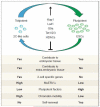Cell totipotency: molecular features, induction, and maintenance
- PMID: 26114010
- PMCID: PMC4477869
- DOI: 10.1093/nsr/nwv009
Cell totipotency: molecular features, induction, and maintenance
Abstract
In mammals, pluripotent stem cells can give rise to every cell type of embryonic lineage, and hold great potential in regenerative medicine and disease modeling. Guided by the mechanism underlying pluripotency, pluripotent stem cells have been successfully induced through manipulating the transcriptional and epigenetic networks of various differentiated cell types. However, the factors that confer totipotency, the ability to give rise to cells in both embryonic and extra-embryonic lineages, still remain poorly understood. It is currently unknown whether totipotency can be induced and maintained in vitro. In this review, we summarize the current progress in the field, with the aim of providing a foundation for understanding the mechanisms that regulate totipotency.
Keywords: Embryonic stem cell; Epigenetics; Pluripotency; Reprogramming; Somatic cell nuclear transfer (SCNT); Totipotency.
Figures


References
-
- Tarkowski AK. Experiments on the Development of Isolated Blastomeres of Mouse Eggs. Nature. 1959;184(4695):1286–1287. - PubMed
-
- Rossant J. Postimplantation development of blastomeres isolated from 4- and 8-cell mouse eggs. J Embryol Exp Morphol. 1976;36(2):283–90. - PubMed
-
- Willadsen SM. A method for culture of micromanipulated sheep embryos and its use to produce monozygotic twins. Nature. 1979;277(5694):298–300. - PubMed
-
- Matsumoto K, et al. Production of identical twins by separating two-cell rat embryos. Gamete Res. 1989;22(3):257–63. - PubMed
-
- Willadsen SM, Polge C. Attempts to produce monozygotic quadruplets in cattle by blastomere separation. Vet Rec. 1981;108(10):211–3. - PubMed
Grants and funding
LinkOut - more resources
Full Text Sources
Other Literature Sources
